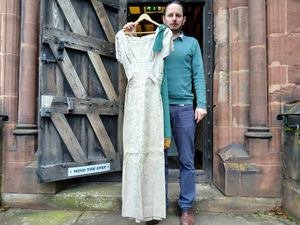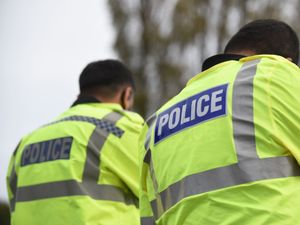See stunning haute couture dress which belonged to female Shrewsbury Major and has found its way to county museum
A stunning haute couture army dress worn by Shrewsbury Major Joan Crooke has been acquired by a county museum.
Watch more of our videos on ShotsTV.com
and on Freeview 262 or Freely 565
The dress is now being looked after by Shrewsbury's Soldiers of Shropshire Museum as the first example of servicewomen’s uniform in the museum’s 39-year history.
The museum hopes to put the dress on display with a number of items relating to Major Crooke.
Major Crooke, who led an impressive near-30-year army career focused on education and training, received the dress in 1962, straight from the London fashion house Worth.
Dr Robert MacKinnon, from the Soldiers of Shropshire Museum at Shrewsbury Castle, explained the history and use of the dress, which is made of rayon.

He said: "Women who were officers in the Women’s Royal Army Corps (WRAC), like Joan, were expected by the army authorities to embody particular ideals of femininity during army social events.
"Joan received one of the first dresses of the WRAC’s new look Mess uniform, produced by haute couture designer Owen Hyde Clark. It is unreservedly feminine through the Empire silhouette and the use of a long green silk sash."
A photograph of Joan wearing the dress has also been donated, along with a shawl and, wonderfully, a handbag containing a little black cat figurine for good luck, a hairbrush with its case, a mirror, and several army dining invitations and place cards.
During the summer, the museum was also able to acquire some of Joan’s personal archive.
After submitting an appeal on Facebook for more information about Joan, distant family members contacted the museum and revealed that they had objects relating to Joan that they were willing to donate for safekeeping - including the dress.
"We leapt at the chance to acquire the dress", Dr Mackinnon explained. "It is a landmark accession for us because although the museum has hundreds of army uniforms, not one is related to a servicewoman. The non-representation of servicewomen’s uniforms stems from a differing museum mission, priority and attitude compared with the museum today.
"We are no longer a museum concentrating solely on the historic (all-male) Shropshire regiments, we are interested in anyone who has both a Shropshire and military link."
Joan was born in Shrewsbury in 1920 and joined the Auxiliary Territorial Service during the Second World War (1939-45).
She returned to Shrewsbury in 1972 on retirement from an impressive army career.
She had achieved the high rank of Major and supported and led assignments all over the UK, mainly focused on education and training.
On at least one occasion Joan considered leaving the Army, but was encouraged by family and friends to stay due to her significant achievements.
It does appear that the Army wasn't Joan’s only passion, as Dr MacKinnon explained: "In 1946 and using the pseudonym ‘Joan Little’ (rather than Crooke), she made a botched attempt to start a film career. She wrote to the famous Hungarian film director Gabriel Pascal.
"He dismissed her enquiry as Joan had stated in her letter she could not act! Undeterred, Joan was to later attain a qualification in drama and pursue amateur dramatics."
Joan led an active retirement in Longden Road, Shrewsbury, and sadly died of cancer at the age of 75 in 1995.
Dr MacKinnon said the museum hopes to place Joan’s dress on display with other items relating to her.
He said it will apply for a grant to undertake some remedial conservation work on the dress so as to return it to the stunning condition it was in when it was first proudly worn.





